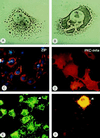Interaction of protein kinase C zeta with ZIP, a novel protein kinase C-binding protein
- PMID: 9177193
- PMCID: PMC21025
- DOI: 10.1073/pnas.94.12.6191
Interaction of protein kinase C zeta with ZIP, a novel protein kinase C-binding protein
Abstract
The atypical protein kinase C (PKC) member PKC-zeta has been implicated in several signal transduction pathways regulating differentiation, proliferation or apoptosis of mammalian cells. We report here the identification of a cytoplasmic and membrane-associated protein that we name zeta-interacting protein (ZIP) and that interacts with the regulatory domain of PKC-zeta but not classic PKCs. The structural motifs in ZIP include a recently defined ZZ zinc finger as a potential protein binding module, two PEST sequences and a novel putative protein binding motif with the consensus sequence YXDEDX5SDEE/D. ZIP binds to the pseudosubstrate region in the regulatory domain of PKC-zeta and is phosphorylated by PKC-zeta in vitro. ZIP dimerizes via the same region that promotes binding to PKC-zeta suggesting a competitive situation between ZIP:ZIP and ZIP:PKC-zeta complexes. In the absence of PKC-zeta proper subcellular localization of ZIP is impaired and we show that intracellular targeting of ZIP is dependent on a balanced interaction with PKC-zeta. Taking into account the recent isolation of ZIP by others in different contexts we propose that ZIP may function as a scaffold protein linking PKC-zeta to protein tyrosine kinases and cytokine receptors.
Figures






References
Publication types
MeSH terms
Substances
Associated data
- Actions
LinkOut - more resources
Full Text Sources
Other Literature Sources
Molecular Biology Databases

